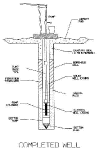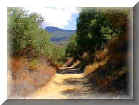The Anatomy of a Country Well
The B & H Ranch has three wells, actually four if
you count the one that's silted in. When we moved to the country in 1989, I pictured
something out of Jack & Jill, a brick structure with a bucket hanging on it.
Modern wells don't do that.
 The well that supplies our
drinking water is a 4" shaft that goes down 200 feet. A 1" steel pipe is
inserted in that shaft with an electrical motor and pump attached at the bottom. The water
is pumped up this pipe to a pressure tank, which tries to keep the water pressure at
around 35 psi.
The well that supplies our
drinking water is a 4" shaft that goes down 200 feet. A 1" steel pipe is
inserted in that shaft with an electrical motor and pump attached at the bottom. The water
is pumped up this pipe to a pressure tank, which tries to keep the water pressure at
around 35 psi.
Specifics
In 1979 when this well was installed, it cost $8.00 per
ft. for the drilling, $4.25 per ft. for a 200 ft liner and another $100 dollars for 20
feet of steel casing. Add on cement and a $25 charge for the permits and the total
job cost $2,600. Unfortunately, there's more. That was just to get the hole
drilled. You still need to have the pump, motor, 200 feet of 1" pipe, pressure tank
and 220 volts of electrical power to make the whole thing work. We're probably over
$5,000 at this point.
To see a simpler version of a manually operated well,
click on the drawing below.

Drawing complements of Lifewater Canada
The following is a list of the frequently
asked questions we often get from our city friends. This information was
gathered from experience with the wells on our property in San Diego County.
Naturally, rules and regulations will vary around the country.
How deep does the well have to be?
Our house well was drilled in a creek bed and
we still had to go down 200 feet. Our second well is at 400 feet though it supplies
a higher volume of water. I guess the answer to the question is "it
depends". Some properties in our area are down around 1,000 feet.
Basically, the drill operator will keep drilling until they obtain a usable flow of water
or the customer runs out of money.
How do I know there will be water where I drill?
A large amount of scientific research goes
into selecting a site for a well but I suspect the final choice is just a wild assed
guess.
Does the well have to be certified and tested?
Yes, depending on your location, wells have to
be tested for contamination. If it doesn't pass, the Department of Public Health
gets involved and we all know how painful that can be!
How much water can be pumped?
Our shallow well was tested at 25 gallons per
minute. That's barely enough to supply our needs around the house. Luckily we have a
3,000 gallon storage tank at the upper end of the property and we can use gravity feed as
a backup.
Is the water safe to drink?
The county health inspectors are going to
see to this. When you purchase a home with a well you will be required to have
the water tested. Common problems are bacterial pollution from near by
septic tanks or animals grazing close by. On rare occasions a well
can be treated by simply poring chlorine down the hole.
What if the well goes dry?
It has happened in our area and usually it
means drilling a new and deeper well.
See http://www.drilshop.com/holes/frac.html
for information on dropping dynamite down your shaft to blast the water out of the rock!!
(We all know how painful that can be). Actually, they inject air at high pressure to
fracture the rock and hopefully create better water flow. Dynamite has been used
with mixed results.

For journal entries about my well repairs, see these
entries - Jan 31,
07 - Jan 19, 07
- Jan 15, 07

